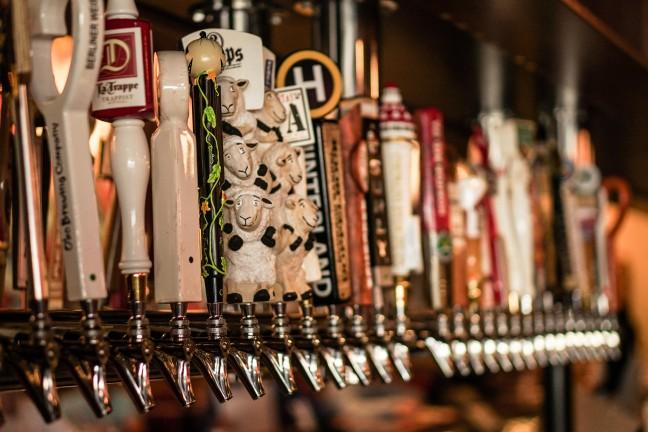Nowadays many people don’t enjoy their beer warm, but for most of the past couple thousand years, warm beer was the norm, according to Kirby Nelson, a brewmaster at the Wisconsin Brewing Company. After all, the predominant yeast species used at the time to brew beer, Saccharomyces Cerevisiae, thrived primarily at room temperature and above.
That all changed in the 15th century when a mystery South American yeast species combined with S. Cerevisiae to make the yeast hybrid that produces lager, the most commonly consumed type of beer. Unlike its parent species, the hybrid performed well at low temperatures, a game-changing advantage, according to University of Wisconsin geneticist Chris Hittinger.
The cold temperatures at which lager was brewed significantly reduced undesirable microbial contamination that had previously existed in warm brew beers, resulting in a crisper, cleaner flavor profile.
In 2011, UW researchers at the Hittinger Lab and their collaborators achieved a major scientific breakthrough when they successfully identified the mystery strain of yeast that hybridized with S. Cerevisiae so many years ago, a distantly related Patagonian species known as Saccharomyces Eubayanus, Hittinger said. Then, a few years later, the researchers isolated a strain of S. Eubayanus right here in Wisconsin.
The local yeast strain, found in Sheboygan, may not seem like much, but it sits at the front of major innovation in the world of lager brewing. In an unlikely partnership between UW researchers and Wisconsin Brewing, the two groups are using S. Eubayanus to make Wisconsin’s first ever ‘wild’ lager, and the second of its kind in North America.
“[S. Eubayanus] has turned out to be quite important because it was the missing link of lager brewing,” Hittinger said. “That’s why people are interested in brewing with it now. All lager brewing uses the interspecies hybrid, but nobody really used the pure wild version of it.”
According to Beeritey, a beer enthusiast blog, lagers are made by first extracting enzymes and sugar-filled liquid from barley to produce wort, a precursor to beer. Next, the wort is prepared and thrown into a fermentation vessel with yeast, allowing it to ferment at a cool temperature.
For the most part, the process for brewing beer with wild yeast is not much different from brewing with the domesticated, hybridized yeast used in lagers around the world, Nelson said. But once the ingredients are inside the fermentation vessel, the fermentation process for the wild yeast strain follows a slightly different path.
Wild yeast consumes less sugar than their domesticated counterparts, and release “smoky, clovey” flavors into the mix, resulting in a sweeter, more distinctive taste, Hittinger said.
Currently, the wild lager is two weeks into its fermentation process at Wisconsin Brewing. Nelson said he is still unsure of how the beer will turn out.
“People keep on coming down to me and asking, ‘How is this beer going to taste?’ and I tell them ‘I don’t know, it’s kind of up to this yeast,’” Nelson said. “Two weeks in, I like the flavor. It’s got a slight Belgian ale characteristic in it. It’s pretty drinkable, but it’s not done.”
UW seniors craft award-winning beer for commercial production
As a matter of policy, Hittinger said his lab assigns all intellectual property to UW’s designated intellectual property agent, the Wisconsin Alumni Research Foundation, as a means of ensuring that the university system and the public own the rights to the research conducted in the lab.
Currently, WARF maintains the intellectual property rights to the Sheboygan yeast strain, Hittinger said.
Although collaboration between the private sector and UW research does occur, Hittinger described the goal of his lab’s research as primarily to educate the public and learn more about the natural world.
“First and foremost, we are driven by discovery and teaching us about the planet we live in, but we do pay attention to when the discoveries we make have practical implications,” Hittinger said. “We try to make sure that when we have discoveries that have potential for application out in the real world, we have partners who can use them in a fair way that benefits the local economy and the university system.”
The collaboration between UW and Wisconsin Brewing has opened the door for many students to participate in research. In fact, Wisconsin Brewing’s relationship with the university began with an 18-student fermentation studies class where individuals from Wisconsin Brewing taught students about the beer brewing process, said Nelson. The students were then given the opportunity to design and brew their own beer.
As the relationship between the university and the company evolved into the wild lager research arrangement, students continued to be involved, Nelson said.
Junior Caroline Miller joined the wild lager project this semester after working at the Hittinger Lab over the summer. Miller says that working in a lab gives her perspective on the differences between research in an academic setting and research in the private sector.
“In a lab setting you’re really zoomed in and get to see unique features on a smaller scale, but in industry, you have to be way more practical,” Miller said. “There you have to think of a lot more variables because you’re going to make a beer that someone’s going to drink. Your goal is different.”
UW alumna talks why she chose brewing classes over medical school
In the lab, Miller works as a liaison between the lab and industry, while at the brewery, she works as an intern, assisting with the research and design of the wild lager brewing process.
Hittinger predicted that the public will react to the wild lager like any other consumer product. Some individuals will love it, while others will avoid it.
“What’s the attractiveness of wild lager? It’s for someone who wants a little more than just something cold in a can that they can slug down at party,” Nelson said. “Here’s something that’s really different: it’s got serious historical precedent, and there’s nothing like that in the market right now.”













